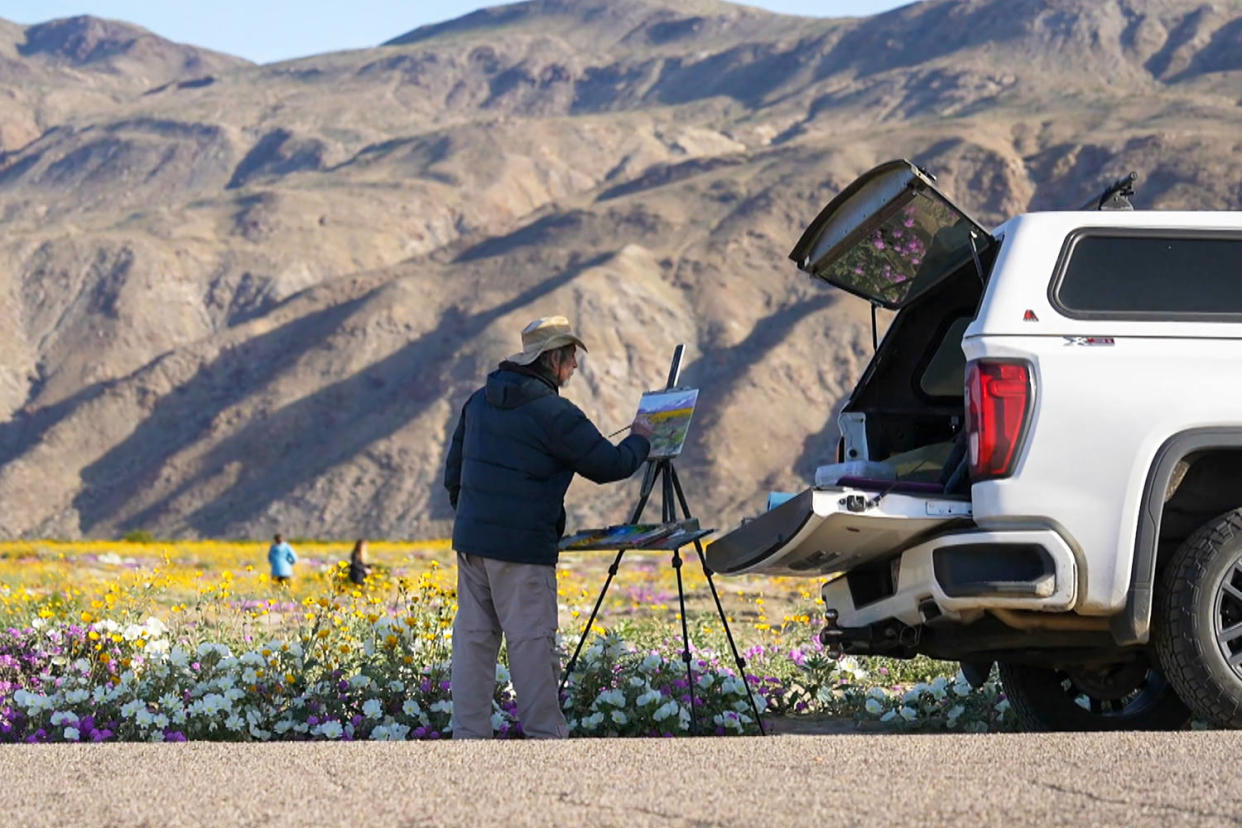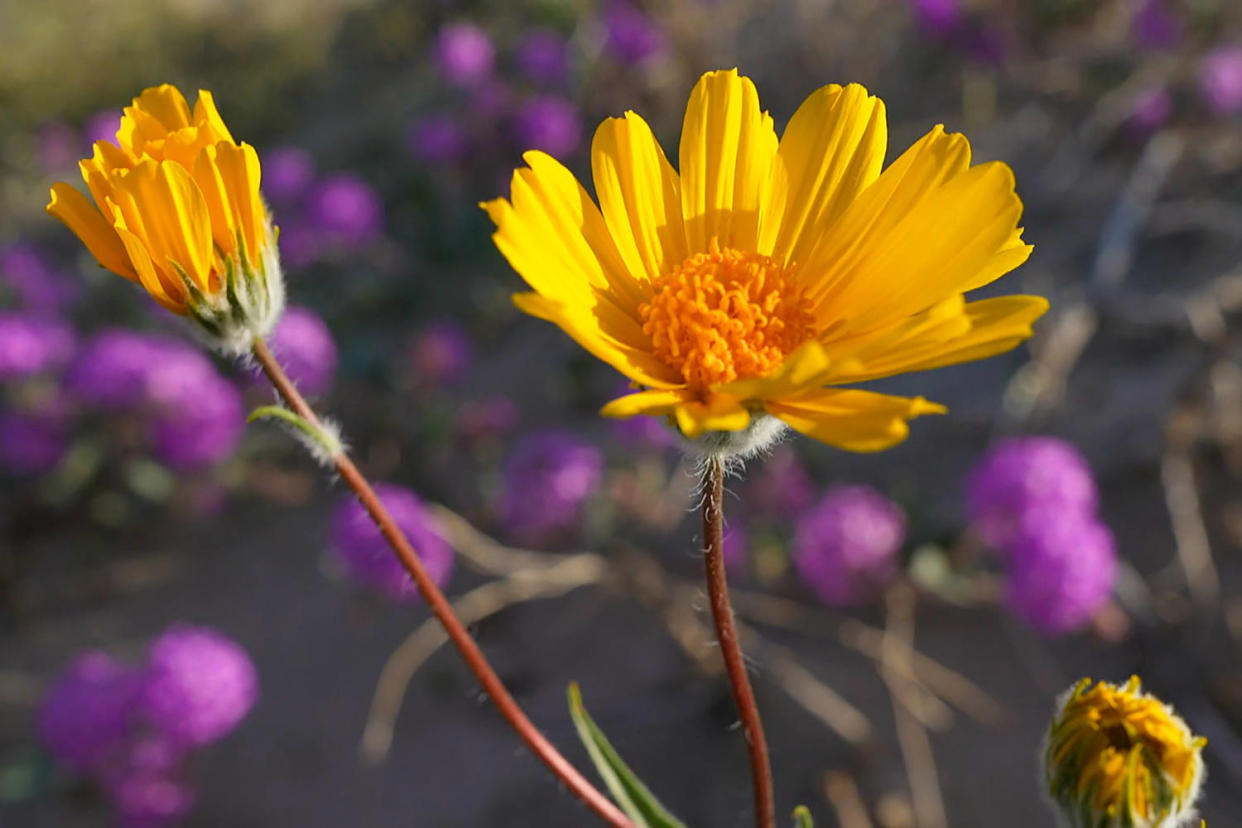Wildflower watchers have reason to believe a 'superbloom' is waiting to erupt in Southern California
ANZA-BORREGO DESERT STATE PARK, Calif. — For most of the year, the hills around Southern California are characteristically brown. Los Angeles’s Mediterranean-type climate survives on an average of less than 15 inches of rain a year, and in areas that are classified as desert, it’s even less.
But near-record winter rainfall has turned those often-brown slopes into seas of undulating green — and in places, a sleeping beauty is slowly awakening.
While a wildflower “superbloom” is hard to predict, experts say a heavy seed load in previous years, combined with the rainfall, could soon make for a must-see kaleidoscope of color in the weeks ahead.
In places like the Anza-Borrego Desert State Park in San Diego County, the bloom is already underway — though it’s too soon to define it as “super.”

Technically, a superbloom is a relatively rare event in which an inordinately high number of dormant wildflower seeds bloom at once. But don’t try telling visitors to the park that what’s already happening is anything less than magical.
“Never in my life would have thought there would be this many flowers in the desert,” said Chandini Sharma, who clutched her iPhone while FaceTiming a friend in India. “She was like, ‘Is this a flower show?’ And I was like, ‘No, no, no, this is a desert. This is a bonafide desert.’”
Vibrant hues of purple, yellow and orange sparkle across the desert floor, with the desert lily, primrose, phacelia and wooly sunflower already putting on a show.
Sharma flew from Oklahoma to see the spring bloom at Anza-Borrego after hearing about it just last week.
“It’s not a superbloom, but it’s pretty darn good for me. I’m happy with this,” she said. “When I got in there, the first thing I said was, ‘If I die and go to heaven, I’ll be OK right now.’ It was literally that kind of a moment.”
Anza-Borrego is one of several landmark sites known for potentially spectacular wildflower blooms. In previous years the excitement has pushed so many visitors to places like Walker Canyon that officials in Lake Elsinore, California, closed roads and pushed visitors to use shuttle buses, while also contending with reports of trampled flowers as shutterbugs sought the most Instagram-worthy shots.
While the crowds have frustrated some, the folks at the Theodore Payne Foundation see an opportunity — teaching Southern Californians and visitors about the amazing ecology of a region close to home. The foundation is a nonprofit organization dedicated to the education, preservation and use of California native wildflowers and plants.
Now in its 41st year, the foundation’s "Wild Flower Hotline" is a bit of old-world charm that delivers very up-to-date lessons on what is blooming and where. And while it does highlight the better-known sites like Anza-Borrego and the Carrizo Plain National Monument when they are in bloom, it also showcases trails just minutes from downtown Los Angeles when the time is right.
“What trails have the best blooms, what roads can you pull over and see wildflowers on the side, what flowers are blooming,” the foundation's executive director, Evan Meyer, said. “It’s sort of like an easy way to get out and connect with nature.”

The hotline — which for the first time is also available in a weekly podcast — is voiced by actor Joe Spano, best known for NBC's “Hill Street Blues,” the movie “Apollo 13” and the CBS drama “NCIS.”
Spano fell into the project years ago given his own love for nature and the Southern California landscape.
“We could plant them and we do plant them in our gardens,” Spano said of wildflowers, “but what’s really magic about them is the fact that you go out and find them. There’s no downside to beautiful flowers coming out of the ground.”
The hotline launched Friday and will run for 12 weeks, or about the time spring turns to summer and the wildflowers say goodbye until next year. And while photos on social media may give it a run for its money, Meyer hopes the nostalgia provides a different inspiration.
“It gets you out of that social media bubble and gets you into nature,” he said.
